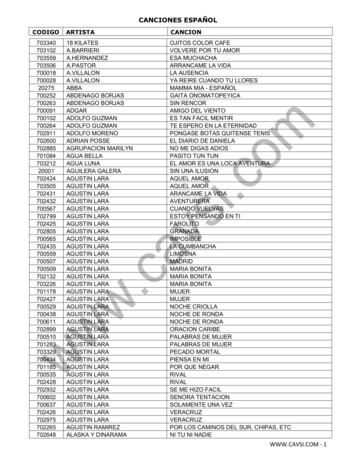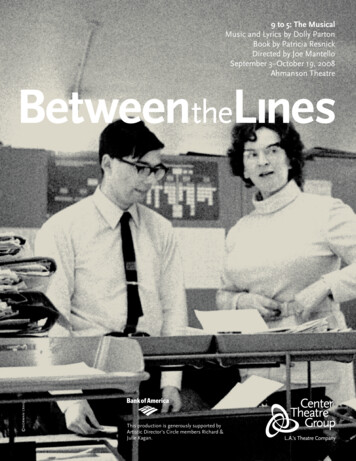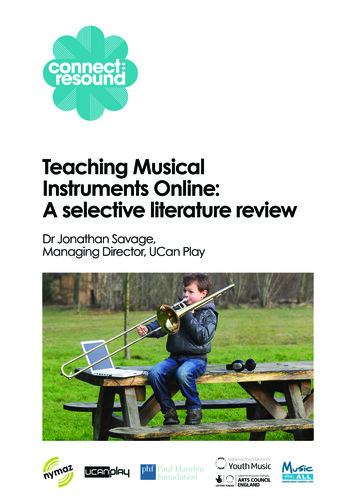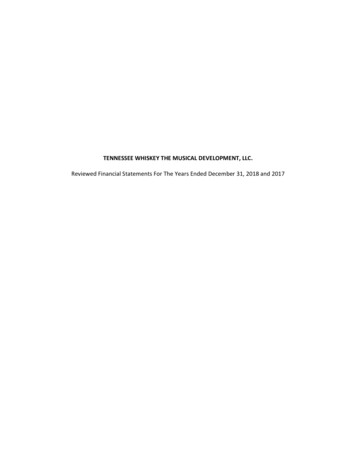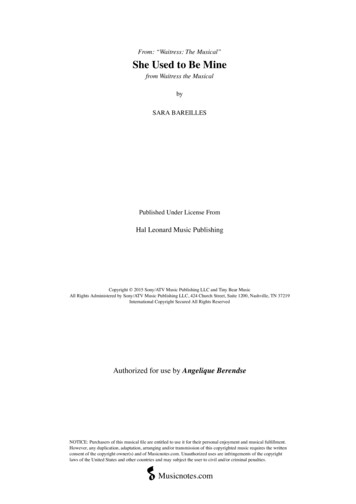
Transcription
THE MUSICAL LANGUAGE OF ALBERTO GINASTERA’S PANAMBÍ ANDTHE INFLUENCE OF CLAUDE DEBUSSY’S LA MER ANDIGOR STRAVINSKY’S LE SACRE DU PRINTEMPSKenneth R. LovernThesis Prepared for the Degree ofMASTER OF ARTSUNIVERSITY OF NORTH TEXASDecember 2015APPROVED:Paul Dworak, Major ProfessorBernardo Illari, Committee MemberDavid Schwarz, Committee MemberFrank Heidlberger, Chair of MusicHistory, Theory and EthnomusicologyBenjamin Brand, Director of Graduate Studies,College of MusicJames Scott, Dean of the College of MusicCostas Tsatsoulis, Interim Dean of theToulouse Graduate SchoolGraduate School
Lovern, Kenneth R. The musical language of Alberto Ginastera’s Panambí and theinfluence of Claude Debussy’s La Mer and Igor Stravinsky’s Le Sacre du Printemps. Masterof Arts (Music Theory), December 2015, 84 pp., 49 illustrations, bibliography, 25 titles.Alberto Ginastera completed his ballet Panambí in 1937. The ballet was arranged as asymphonic suite, and was performed the same year at the Teatro Colon in Buenos Aires,conducted by Juan José Castro. Panambí marked the beginning of Alberto Ginastera’s long andsuccessful career as an Argentine composer. Chapter I of this document provides a briefintroduction into the history behind Alberto Ginastera’s Panambí suite, and includes a review ofthe research that is exclusively devoted to the suite, as well as documents that do not providedirect analyses of Panambí, but contain information that aid in a better understanding of thesuite’s composition. Chapter II includes analyses of the suite that illustrate important elementsthat contribute to the structure and sound of the Panambí suite. These components includeGinastera’s construction of the La Noche theme found in the first movement and its use as amaster set, his use of diatonic collections and pitch centricity, the importance of unordered pitchclass intervals IC1 and IC6, his use of aggregate completion as a compositional method, and hisuse of local motives over larger spans of temporal space. Chapter III explores the possibility thatmany of these compositional methods are due to the influence of Claude Debussy’s La Mer andIgor Stravinsky’s Le Sacre du Printmeps. The “guitar chord” may also be the result of theinfluence of Debussy’s La Mer.
Copyright 2015byKenneth R. Lovernii
TABLE OF CONTENTSLIST OF EXAMPLES . ivCHAPTER I: INTRODUCTION .1Background .2Related Research: Scholarship Exclusively Devoted to the Panambí Suite.3Related Research: Scholarship Indirectly Related to the Panambí Suite .5CHAPTER II: THE MUSICAL LANGUAGE OF PANAMBÍ INTRODUCTION .13The La Noche Theme, mm. 1-6, as a Master Set .16Chromatic Aggregate Completion .22Use of Diatonic Collections and Pitch Centricity .29The Use of IC1 and IC6 .41Composing-Out of Thematic Material .51CHAPTER III: THE INFLUENCE OF DEBUSSY’S LA MER AND STRAVINSKY’S LESACRE DU PRINTEMPS Introduction .66The Influence of Debussy’s La Mer .67The Influence of Stravinsky’s Le Sacre du Printemps .74Conclusion .80BIBLIOGRAPHY .83iii
LIST OF EXAMPLESEx. 1, Standard guitar tuning .6Ex. 2, Danza del Viejo Boyero from Danzas Argentinas, Op.2, mm. 78-79 .6Ex. 3, Symmetrical structure of Panambí first movement as described by Grace Campbell .9Ex. 4, La Noche theme, first movement, mm. 1-6 .17Ex. 5, Pitch-class set [5678TE013] found in the first movement, mm. 1-6, and its complement[249] .18Ex. 6, Transition from pitch-class set [5678TE013]/set class (01235678T), to notes A and E,which are part of pitch-class set [249]/set class (027) .19Ex. 7a, The formations of set classes (0167), (0158), (0257), and (0358) .21Ex. 7b, The appearance of set classes (0158), (0258) and (0358) within the Canto del Paranátheme, first movement, mm. 30-32 .21Ex. 8a, Chromatic aggregate completion, first movement, mm.1-10 .24Ex. 8b, Pitch occurrences, first movement, mm. 1-10 . 25Ex. 9a, Chromatic aggregate completion, fifth movement, mm. 18-25. 26Ex. 9b, Pitch occurrences, fifth movement, Flutes 1&2 and xylophone, mm. 18-25 .26Ex. 10, Completion of pitch-class set [681]/set class (027), fifth movement, mm. 18-25 .27Ex. 11a, Chromatic aggregate completion, fifth movement, solo flute and oboes, mm. 1-9 .28Ex. 11b, Pitch occurrences, fifth movement, solo flute and oboes, mm. 1-9 .29Ex. 12, “Rubin’s Vase.”. . .30Ex. 13a, The use of the F sharp diatonic collection, first movement, mm. 1-6 .32Ex. 13b, The use of the F sharp diatonic collection, and F sharp as a centric pitch, firstmovement, mm.1-6 .33Ex. 14, The formation of set classes (0158), (0258), and (0358) within the C major diatoniccollection .34iv
Ex. 15, The use of the C major and F sharp major diatonic collection during the Canto delParaná theme, mm. 30, first movement .36Ex. 16a, The formation of an A major triad, and set class (0148) tetrachord harmonies, sixthmovement, Danza de los Guerreros .38Ex. 16b, Formation of set class (01235678T), related to master pitch class set (01235678T)found in the first movement, by T8, and the presence of set classes (0158) and (0257) .39Ex. 16c, Use of the A major diatonic collection in the movement, Danza de los Guerreros, mm.11-20 .39Ex. 17, The transposition of set class (0135) and the use of C sharp as an axis, sixth movement,mm. 11-20 .41Ex. 18, Intervals formed by pitch-class sets [56E0] and [0167]/ set class (0167), first movement,mm. 1-6 .42Ex. 19, The formation of the Z-cell .43Ex. 20, Simultaneous employment of “anhemitonic” Z-cell and hemitonic Z-cell, Danza de losGuerreros, m.35 .46Ex. 21, The formation of set class (0167), and ordered pitch intervals, Lamento de las Doncellas,mm. 6-9 .47Ex. 22, Structural use of IC1 within the string section, Ronda de las Doncellas, mm. 1-6 .49Ex. 23, The resolution of the diminished fifth (IC6), and the transformation of hemitonic Z-cell/set class (0167) into “anhemitonic” Z-cell/ set class (027), within the first movement,mm. 60-63 .51Ex. 24, A: Transposition of set class (026), sixth movement, m. 51. B: Transposition of set class(026) and presence of master set class (01235678T), first movement, mm. 1-7. C: Formation ofmaster set class (01235678T), sixth movement, m. 51 .54Ex. 25, The composing-out of set class (026) and the formation of pitch-class set [0167]/ setclass (0167), Lamento de las Doncellas, third movement, mm. 1-5 .56Ex. 26, The composing-out of set class (026), Lamento de las Doncellas, third movement, mm.6-9 .57Ex. 27, The transformation of set class (0258) in the first movement, Claro de Luna Sobre elParaná.60v
Ex. 28, The resolution of large scale C major minor seventh to pitch-class set [4590]/ set class(0158)/ F major major seventh, in the first movement, m. 53 .62Ex. 29a, The structural use of set class (0167) and the transformation of set class (0167) into setclass (027), first movement, Claro de Luna Sobre el Paraná .64Ex. 29b, The conversion of set class (026) into (025) in the first movement, Claro de Luna Sobreel Paraná .64Ex. 30a, The formation of set classes (0167) and (0258) in the first movement of La Mer,mm. 6-9 .69Ex. 30b, The formation of set classes (0167) and (0258) in the first movement of Panambí, mm.16 .69Ex. 31a, The formation pitch-class set [E35]/ set class (026), pitch intervals, and contour segmentin La Mer, third movement, mm. 96 97 .71Ex. 31b, The formation pitch-class set [E35]/ set class (026), pitch intervals, and contoursegments in Panambí, first movement, mm. 1-2 .71Ex. 32a, The use of the “guitar chord” set class (02479) in m. 31 of the first movement ofLa Mer 73Ex. 32b, The use of the “guitar chord” set class (02479) in m. 30 of the first movement, duringthe Canto del Paraná section in Panambí .74Ex. 33a, The orchestration of the second movement of Le Sacre du Printemps,mm. 3-6 .76Ex. 33b, The orchestration of the sixth movement of the Panambí suite, Danza de los Guerreros,mm. 3-4 .76Ex. 34a, The use of IC1 and the formation of set class (0257) in Le Sacre du Printemps, tenthmovement, Mystic Circle of the Adolescents, mm. 25-28 .78Ex. 34b, The use of IC1 in Panambí, the fifth movement, Ronda de las Doncellas,mm. 2-6 .78Ex. 35a, Alterations of set classes (0158), (0258) and (0358) in Stravinsky’s Le Sacre duPrintemps, second movement, mm. 119-122.79Ex. 35b, Alterations of set classes (0158), (0258) and (0358) found in Ginastera’s Panambí suite,first movement in mm. 30-32 .80vi
CHAPTER IINTRODUCTIONAlberto Ginastera first started composing Panambí in 1934 and completed it in 1937,when he was twenty years old, while attending Conservatorio Nacional de Música y ArtesEscénico in Buenos Aires where he studied composition under Jóse André and Carlos LópezBuchardo. It was originally composed as a complete ballet subtitled “a choreographic legend inone act.”1 This work was first discovered by conductor and composer Juan José Castro whocame across the Panambí ballet Op. 1 while searching through the archives of the Teatro Colońof Buenos Aires for performance material. Castro was impressed by the ballet and contacted theyoung Ginastera. Months went by until they finally met, and Castro asked Ginastera if he hadany orchestral works that were written and ready to perform, but Ginastera did not. Castro thensuggested that Ginastera use selected excerpts of the Panambí ballet and arrange them as anorchestral suite. Juan José Castro directed the first performance of the Panambí suite Op. 1a atthe Teatro Coloń in Buenos Aires on November 27, 1937. The complete ballet was performed atthe same theater on July 12, 1940, conducted by Castro, with dance choreography provided byMargarita Wallman.2 The suite was first performed in the United States in Washington D. C.,February 1946 by the NBC Symphony Orchestra, conducted by Erich Kleiber.3This thesis focuses on this first known orchestral work written by Alberto Ginastera. Myanalyses show that set-class (01235678T), which is presented at the beginning of the firstmovement of Panambí, suite Op. 1a, and its subsets (02479), (0158), (0257), (0258) and (0358),1David Edward Wallace, “Alberto Ginastera: An Analysis of his Style and Techniques of Composition”(PhD diss., Northwestern University, 1964), 39.2Ibid., 39.3Ibid., 40.1
are used to construct harmonies, both vertical and arpeggiated, and motives throughout the work.Permutations of these sets, such as transposition, inversion, and composing out these sets overlarger expansions of temporal space, are demonstrated in my analyses. This thesis also exhibitsthe compositional use of set-class (027), which is the complement set of set-class (01235678T).The analysis results show that Ginastera’s use of these sets, and other compositional techniquesemployed in Panambí, have been influenced by Debussy’s La Mer and Stravinsky’s Le Sacre duPrintemps. In addition, this thesis investigates the “guitar chord” harmony, set class (02479),found within the Panambí suite.BackgroundThe Panambí ballet is based on a romanticized myth of the Guaraní people.4 The actionof the ballet takes place around the Paraná River in northern Argentina and southern Paraguay.The story that drives the action of the ballet was written by Felix L. Errico, 5 and a synopsis ofthe inspirational legend is included at the beginning of the score of the suite.According to the legend, Panambí was the beautiful daughter of the chieftain of an Indiantribe established on the banks of the Parana River. She was betrothed to Guirahú, themost valiant warrior of the tribe, who, shortly before the wedding day is kidnapped by themaiden spirits of the river. The tribe sorcerer, who is also in love with Panambí but hasbeen rejected by her, takes advantage of the situation to try and take revenge upon her,and consequently claims that the almighty spirits decree that Panambí should descendinto the river in quest of her lover. The maiden is ready to carry out the supposedly divineorders when Tupá, the good god, appears from above and stops her, whereupon hepunishes the sorcerer by turning him into a strange black bird and restores Guirahú, whorises from the waters of the river to throw himself into the arms of his loved one.64The Guaraní are native South American peoples who reside in Paraguay and parts of Argentina, Brazil,Uruguay and Bolivia.5Deborah Schwartz-Kates, Alberto Ginastera: A Research and Information Guide (New York: Routledge,2010), 44.6Alberto Ginastera, Suite del ballet Panambí (Buenos Aires: Barry Editorial N.D.), 1.2
The titles of the suite movements describe the action of the ballet: “Moonlight on theParaná,” “Invocation of the Powerful Spirits,” “Lament of the Maidens,” “Indian Festival,”“Rondo of the Maidens,” and “Dance of the Warriors.” The suite is scored for orchestra andincludes a large percussion section, which Ginastera features frequently within the suite. Theyoung Ginastera showed an early talent for orchestration in Panambí.Related Research: Scholarship Exclusively Devoted to the Panambí SuiteI discovered three pieces of academic writing that include analyses of the Panambí suiteOp. 1a. The earliest written is David Wallace’s dissertation titled “Alberto Ginastera: AnAnalysis of His Style and Techniques of Composition” written in 1964.7 In 2000, Luis FernandoJimenez wrote his dissertation “An Analysis of Three Representative Works of AlbertoGinastera: Panambí Op. 1a, Variaciones Concertantes Op. 23, Glosses Sobre Temes du PauCasals Op. 48.”8 The most recent analyses offered on the Panambí suite are included in anarticle written in 2001 by Dante Grela titled “Tres expresiones de la creación musicallatinoamericana en la primera mitad del siglo XX.”9David Wallace’s dissertation addresses much of Ginastera’s œuvre by providing abiographical history and form analyses. He also points out Gaucho influence displayed inGinastera’s music and illustrates characteristics of specific musical gestures. Thirteen pages arededicated to the Panambí suite Op. 1a, in which Wallace details the history of the work, provides7Wallace, “Alberto Ginastera.”8Luis Fernando Jimenez, “An Analysis of Three Representative Works of Alberto Ginastera: Panambí Op.1a, Variaciones Concertantes Op. 23, Glosses Sobre Temes du Pau Casals Op. 48” (PhD diss., PeabodyConservatory of Music, 2000).9Dante Grela, “Tres expresiones de la creación musical latinoamericana en la primera mitad del siglo XX,”Musica e Investigation, no. 4 (2000-2001): 75-110.3
a formal analysis of five of the six movements of the suite, and describes musical ideas thatdefine specific sections of each movement. He omits the fourth movement, Fiesta indígena, inhis analyses.10 Although Wallace’s discourse on Panambí is brief, he does provide usefulbiographical information about the composer and a detailed form analysis of the composition’smovements.Luis Fernando Jimenez’s dissertation devotes nine pages to Ginastera’s Panambí, inwhich the author provides a brief history of the suite and describes the musical details of eachmovement chronologically as they happen in time. In addition, Jimenez illustrates what hebelieves to be examples of malambo metrical treatment found within specific movements,describes much of the harmonic texture of the Panambí suite as polytonal, and connects thedriving rhythms of the suite to stylistic features of primitivism.11Dante Grela’s article analyzes Uirapurú, written by Heitor Villa Lobos, Sinfonia Indiacomposed by Carlos Chavez, and Panambí by Ginastera. Eight pages are devoted to all sixmovements of the Panambí suite, in which Grela uses his own specialized terminology todescribe what he feels is occurring within the music. Grela defines harmonic and motivicgestures within the first movement as sound objects that are experienced on foreground andbackground levels by the listener. These sound objects are categorized as either continuous ordiscontinuous. Continuous sound objects are those motivic gestures that are repeated throughoutmovements of the suite, whereas discontinuous sound objects appear once and never return.Grela further conceptualizes these sound objects as ornamental, which are gestures that aredecorative, and non-ornamental gestures, which are important figures that define the structure of10Wallace, “Alberto Ginastera.”11Jimenez, “An Analysis of three representative works of Alberto Ginastera.”4
the work. Other aspects of the six movements of the Panambí suite that Grela addresses in hisanalyses are formal unity that is created by Ginastera’s use of macro and micro structures, aswell as larger symmetrical structures found within the suite.12Related Research:Scholarship Indirectly Related to the Panambí Suite.I discovered scholarship that is useful in better understanding the Panambí suite’smusical language even though these studies do not provide in-depth analysis of the suite itself.The most common recurring topics found in these documents when discussing Ginstera’s musicare as follows:1. The appearance of the “guitar chord” harmony found in Ginastera’s music that servesas an archetype of the Gaucho tradition.2. The influence of criollo folk music, specifically Gaucho genres and rhythms, such asthe malambo and its variants.Malena Kuss discusses the “guitar chord” in her article "Type, Derivation, and Use ofFolk Idioms in Ginastera's ‘Don Rodrigo’ (1964)." The “guitar chord” refers to a gesture thatemulates the open strings of the guitar in standard tuning, and is found in many of Ginastera’sworks. Often these gestures are presented as an arpeggio, as if a guitar player was plucking theopen strings of the instrument individually and in order, starting with the sixth string (lowestsounding string) and moving down to the first string (highest-sounding string) as shown inExample 1 and Example 2.12Grela, “Tres expresiones de la creación musical latinoamericana en la primera mitad del siglo XX.”5
Example 1: Standard guitar tuning.Example 2: Ascending arpeggio of the “guitar chord” found in Danza del Viejo Boyerofrom Danzas Argentinas, Op.2 mm. 78-79.Malena Kuss illustrates how Ginastera used the “guitar chord” as a source to generatetwelve-tone rows that are present in his opera Don Rodrigo. Kuss begins her article by pointingout Ginastera’s earlier uses of the “guitar chord” and identifies this musical gesture as a nativeidiom. The author then details how Ginastera used specific aspects of the guitar’s tuning to forman anhemitonic Z-cell (E, A, B, E). According to Kuss, Ginastera converted this Z-cell into a6
hemitonic type (E natural, A, B flat, E flat/ set class (0167)) that was used as the first tetrachordfound in the basic twelve-tone series. Other twelve-tone rows are assigned to specific charactersof the opera, and some are associated with the dramatic action of the libretto. 13 Kuss’s article“The Structural Role of Folk Elements in 20th-century Art Music” further describes the presenceand derivation of the Z-cell in the works of Ginastera, Bartok, and Alban Berg. A comparison isalso made within this writing between Ginastera’s syntheses of the character’s twelve-tone rows,to Alban Berg’s Lulu, which uses a similar type of procedure (This is discussed in more detailstarting on p. 43).14Carlos A. Gaviria wrote a thesis titled “Alberto Ginastera and the Guitar Chord: AnAnalytical Study,” which provides a detailed account of occurrences and transformation of theguitar chord harmony in Ginastera’s music. The pieces that Gaviria provides analysis for areDanza del Viejo Boyero (Example 2), from Danzas Argentinas, Op.2 (1937), Malambo, Op. 7(1940), Cuadro I – El Amananecer, Introducción y escena from the ballet Estancia, Op.8.(1941), Triste from Cinco Canciones Populares Argentinas, Op. 10 (1943), VariacionesConcertantes, Op. 23: Tema per violoncello ed arpa, Interludio per Corde (1953) and Sonatafor Guitar Op. 47, I. Esordio (1976). Set theory is the main methodology used to analyze how the“guitar chord” is transposed and modified within the selected pieces, which span a large portionof Ginastera’s compositional career.1513Malena Kuss, "Type, Derivation, and Use of Folk Idioms in Ginastera's "Don Rodrigo" (1964)." LatinAmerican Music Review / Revista de Música Latinoamericana 1, no. 2 (Autumn –Winter 1980): 176-195.14Malena Kuss, "The Structural Role of Folk Elements in 20th-century Art Music." Atti del XIV congressodella Societa Internazionale di Musicologia, Bologna, 1987: Trasmissione e recezione delle forme di culturamusicale, Torino, Edizioni di Torino, 1990. 99-119.15Carlos A Gaviria, "Alberto Ginastera and the guitar chord: An analytical study," (M.M. thesis, Universityof North Texas, 2010).7
Two other documents that I believe are specifically be useful in understanding themusical language of the Panambí suite are Grace M. Campbell’s dissertation, "Evolution,Symmetrization, and Synthesis: The Piano Sonatas of Alberto Ginastera," written in 1991, andEric Carballo’s dissertation titled "De la pampa al cielo: The Development of Tonality in theCompositional Language of Alberto Ginastera," written in 2006.16 Both devote large sectionsthat describe influences such as the malambo and other Gaucho genres, criollo folk music, IberoAmerican and Amerindian traditions, as well as the influence of Argentine folk musicologistCarlos Vega and Isabel Aretz. The term Amerindian is directly taken from Campbell’sdissertation. It should be noted that Aborigen is the most common term used in Argentina todescribe indigenous peoples of the Americas.Grace Campbell’s dissertation provides analyses of the three piano sonatas of Ginastera,in which she discusses Ibero-American and Amerindian influence in Ginastera’s music as well asthe appearance of malambo rhythms, malambo variants and the “guitar chord.” Campbell alsoprovides a very brief analysis of the first movement of the Panambí suite. Much like DanteGrela’s analysis, Campbell devotes a large portion of her text to describe symmetrical structuresat micro and macro levels and illustrates the symmetry of tonal centers found within the firstmovement of the Panambí suite where “Ginastera incorporates a variety of symmetricalformations within a succession of clear tonal centers. The symmetry of the work is demonstratedin the first movement of the work, ‘Claro de luna sobre el Paraná.’ The climax of the movement,16Erick Carballo, "De la pampa al cielo: The Development of Tonality in The Compositional Language ofAlberto Ginastera" (PhD diss., Indiana University, 2006).Grace M Campbell, "Evolution, Symmetrization, and Synthesis: The Piano Sonatas of Alberto Ginastera"(PhD diss., University of North Texas, 1991), 5.8
the ‘Canto del Paraná in the horns, is centered between a succession of tonal areas movingsymmetrically by interval 3 and 4 from the center.”17Example 3: Symmetrical structure of Panambí first movement as described by GraceCampbell.18These tonal centers that Ginastera used within the Panambí suite are one of the maintopics of my thesis. It is my belief that Ginastera established many of these centers through pitchcentricity, and that most of these adjacent tonal centers found in the first movement form setsthat are based on the initial theme, thus composing out said theme over larger spans of temporalspace. This is discussed in further detail in the next chapter.Eric Carballo discusses in his dissertation the appearance of malambo, which is atraditional Argentine dance accompanied by guitar, in Ginastera’s compositions. Carballodivides Ginastera’s use of the Gaucho genre into two categories, the traditional malambo (whichhe calls “extroverted”), and a questionable second type of his own invention which recognizes nofolk models, the “introverted” malambo. Carballo also addresses the guitar chord and illustrateshow Ginastera uses this gesture as a structural sonority. Carballo centers much of his thesis on17Campbell, "Evolution, Symmetrization, and Synthesis."18Ibid., 5.9
the establishment of tonal centers in Ginastera’s music, as well as on tonal expansion andprolongation of dissonant harmonies. The author utilizes Schenkerian analysis as themethodology to express these characteristics found in various works from Ginastera’s œuvre.19In addition, Carballo points out the potential influence of Argentine folk musicologistCarlos Vega, and describes Vega’s theories on rhythm, meter and phrasing. I was unable to findany direct evidence in the Panambí suite that suggests that Carlos Vega’s theoretical principlesaffected Ginastera’s compositional approach.Another writing that I believe is helpful in developing my thesis, and is similar in itsmethodological approach is Jessica Barnett’s thesis “Alberto Ginastera’s String Quartets nos. 1and 2: Consistencies in Structure and Process.” This writing uses set theory to analyzeGinastera’s String Quartet No. 1, which is non-serial, and String Quartet no. 2, which wasGinastera’s first serial work. The topics that are addressed in this thesis are large-scale form andsource collections of the quartets, motivic pitch structure and compositional process, andcomposing-out tech
The story that drives the action of the ballet was written by Felix L. Errico, 5 and a synopsis of the inspirational legend is included at the beginning of the score of the suite. According to the legend, Panambí was the beautiful daughter of the chieftain of an I
